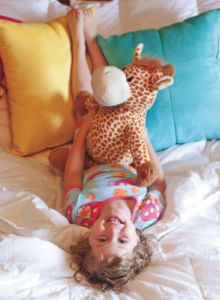Is “bedtime” a bad word at your house? Do your children fight sleep like trained ninjas? Does the tuck-in process leave you tuckered out? If bedtime is a battle night after night, sleep cues may be your ticket to success.
Just what is a sleep cue? Known as “sleep onset associations” by medical professionals, sleep cues are the building blocks of an effective bedtime routine. When used consistently, sleep cues tell the brain that it’s time to slow down. With a few tweaks to your evening rituals, you can create powerful sleep cues that will help everyone wind down and relax—even children who are too old for lullabies and bedtime stories.
From the age of six months, children can develop associations between certain events or objects and falling asleep. “Most importantly, children need to sleep in their own bed in a secure sleep environment,” says local pediatrician Dawn Vick.
These scientifically-proven cues will help your brood wind down, feel sleepy, and actually want to go to bed.
Cue 1: Made in the shade
According to Dawn Vick, M.D., a dark bedroom is important to healthy rest. “The lights should be out but a small nightlight is acceptable since many children don't feel comfortable in complete darkness.” Darkness also plays a major role in sleep preparation; it cues the brain’s production of melatonin, known for regulating biological rhythms and helping us feel sleepy.
Make it work for you:
Create a peaceful, sleep-inducing atmosphere by dimming the lights after dinner. Stumbling around in the dark isn’t necessary; just draw the shades and turn off unnecessary lights about an hour before bedtime. Collins recommends turning off or covering all light sources in the bedroom, including lighted clocks, electronic toys and screens.
Cue 2: Sound of music
For an easier bedtime, make some noise. Consistently using sound or music near bedtime creates a positive sleep association that cues relaxation. Whether you choose classical music, rainforest sounds, ocean waves or plain old white noise, the type of sound is less important than using it repeatedly. Over time, the sound will signal to your child’s brain that sleepy time is near.
Make it work for you:
To incorporate noise into your bedtime routine, simply choose any type of sound you and your family find soothing. “Sound machines are fine particularly if the home is noisy or in a loud area,” Vick explains. Play soft music or white noise 30 minutes to an hour before bedtime for a subtle yet effective cue that it’s time for sleep.
Cue 3: Nighttime nosh
A bedtime bite banishes hunger and provides an important sleep cue that children learn to associate with bedtime. Depending on what children eat, snacks may help them fall asleep faster, too. When paired with complex carbohydrates, tryptophan-rich foods like meat, dairy, soy, or nuts can help children feel sleepy—the insulin spike that follows carbohydrate consumption helps tryptophan enter the brain.
Make it work for you:
Serve a wholesome snack about an hour before bed. Consider tryptophan-carbohydrate combos like whole-grain cereal and milk, oatmeal cookies and cocoa, whole-wheat crackers and cheese or sesame seeds sprinkled on half a peanut-butter sandwich.
Cue 4: Smells like bedtime
Ancient folklore and modern science are in agreement about the calming effects of scents. Lavender aromas have been proven to slow the nervous system and promote deep sleep. German researchers recently proved that the scent of Gardenia jasminoides has a powerful sedative effect. When used near bedtime, a soothing scent signals to your family that the day is over (and makes your house smell great, too).
Make it work for you:
Incorporate scent into your evening ritual by gently simmering water infused with essential oils or vanilla extract, plugging in a child-safe scent diffuser or (carefully) lighting a scented candle with your children.
Cue 5: Sleep security
“Toddlers often feel more secure and have less sleep problems if they sleep with a transitional object,” says Vick. Security objects like stuffed animals or “lovies” are powerful sleep cues, she adds. Sleep specialists call these items “transitional objects” because they ease the transition to slumber. They’re often the last element of a bedtime routine and remain with the child as she drifts off to sleep.
Make it work for you:
According to Vick, the ideal transitional object is one the child controls herself. Snuggling a favorite toy is good, she notes, because a child can do this throughout the night as needed without getting up or waking others. She points out that a pacifier or cup may not be the best item to use. Books, music and well-loved toys also work well, as long as a parent isn’t called on to locate it, wind it up or turn it on in the middle of the night.
“Sleep time should be very routine and consistent for all children, from babies to teenagers,” Vick comments. Keeping sleep cues simple is the key to success. Try a few cues on your children and see what magic unfolds. When bedtime is a breeze, you’ll actually enjoy it. And, once the children are asleep, you’ll have plenty of energy left over for that pile of laundry.






